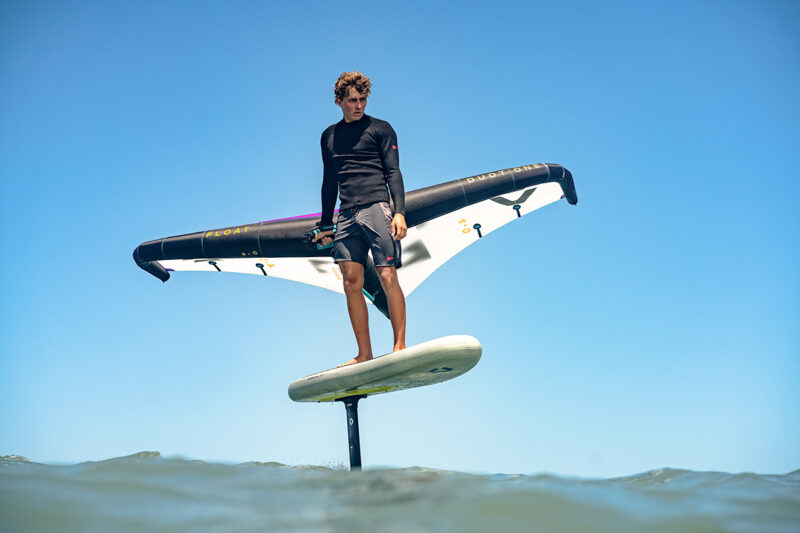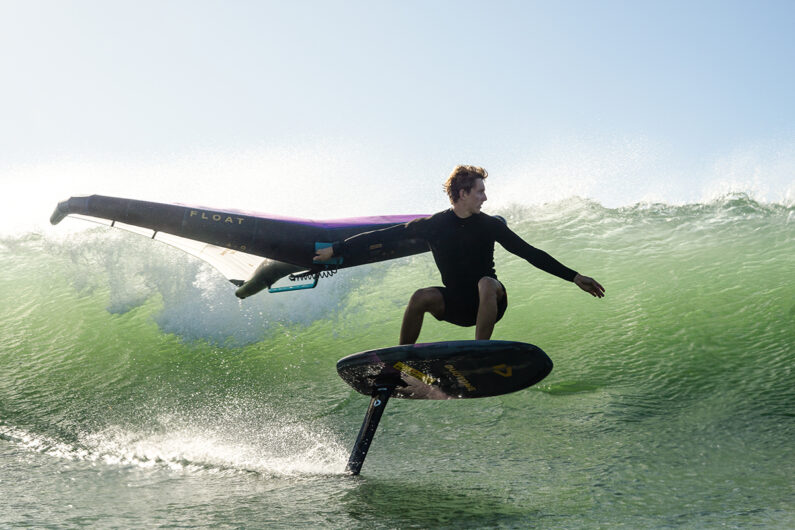FORESIGHT: Phil Martin
Offering his industry-level-insight into where the sport of foiling is likely to find itself in the coming years is Eleveight Co-founder and Sales Manager, Phil Martin…
READ MORE

Designer Ken Winner gives us the full insight into Duotone’s newest arrival into their wing line-up – and the two brothers who were a key part of its inspiration…
First up, tell us the concept of this new wing and which discipline it’s focused on…
Our most popular wing, the Unit, started as a wave and downwind wing but evolved into an all-around wing. Freestylers, racers, jumpers, surfers, downwind riders and cruisers used it equally and it had fallen away from a pure focus on wave riding. We decided to refocus a new wing, the Float, very narrowly on wave and downwind surfing, gliding performance.
A huge part of this process was to rely extensively on the skill, judgement and experience of Jeffrey and Finn Spencer, two of the world’s earliest and best wing surfers; riders who have placed highly in international competition in the sports of wing foiling and SUP foiling.
Obviously, a good wave wing needs to have great roll stability. Finn and Jeffrey added that it should have good “follow-ability,” the ability to follow them when they turn up and down the face of a wave.
Another key feature that Jeffrey and Finn demanded was neutral lift while luffing. Many of our wings in the past have had positive lift while luffing, which helps a wing to feel light in the hand, but our riders felt that neutral lift would make surfing, tacking and other maneuvers easier, less “draggy” and more intuitive.
Finally, Finn and Jeffrey felt we needed to dramatically upgrade the handle on the leading edge to a stiffer construction. This would give the rider quick and precise control over wing roll and yaw, thus preventing flaws in the wind or sudden changes in rider direction to create instability. The Float leading edge handle also has a larger diameter, more like the grip diameter of the boom.
In the Float, we continued our exploration of different amounts of leading edge sweep and dihedral. In the 2024 and 2025 Units we tested wings with a range of sweep angles (the amount the leading edge angles back toward the leech of the wing) but mostly fairly high, swept-back angles. With the Float we experimented with very low sweep angles, much like what we have in the Ventis. It turned out that the low sweep angles were better for luffing stability.
We also tested different dihedral angles. We found more dihedral was worse for roll stability, while lower dihedral angles were worse for controlling canopy tension precisely. We settled on a dihedral much like that of the Unit.

How has this wing been specifically tailored for optimal performance in the waves?
This wing has low sweep in the leading edge, a moderate dihedral, similar to the Unit dihedral as mentioned previously, light tension in the front of the canopy, a wide, stiff leading edge handle, low overall weight and neutral lift while luffing. All of these factors make it a true weapon in the waves.
Durability is a big factor when you take a pasting in waves, but how have you balanced this with the overall weight, which we know is a critical factor?
We wanted the Float to be as light as possible without resorting to exotic and expensive materials, so we stayed with proven Dacrons and ripstops but eliminated the heavier Dacron in the center of the LE and went instead with a bit larger diameter to maintain stiffness. We also eliminated windows, because the window material is quite heavy, on the theory that surf wings spend a lot of time being luffed, when windows are of no use anyway.
Have you opted for a loose or tight canopy design, and why?
We found that high canopy tension can help make a wing fast and stable when sheeted in, and that it can prevent the center of effort of the canopy from moving back in a gust, but we also found that high canopy tension in the front can make a wing less stable while luffing. This is something we found out years ago but did not really take advantage of until we started working on the Float.
The Float has low canopy tension in the front 30% and this allows the front of the canopy to luff freely when sheeted out. This luffing creates drag that tends to stabilize the wing in the roll direction. At the same time, we maintained good leech tension so that the wing will have good pumpability and power.
Interestingly, we had to put different amounts of tension in the canopy of different size Floats. The bigger ones have more tension in the front of the canopy so that draft does not move too far back in gusts, while the smaller sizes have considerably less tension in the front 30%. This gives these wings great low-end power and a wide angle-of-attack sweet spot. The small Floats are more forgiving than most riders would expect.
What handle setup does the Float come with? Talk to us about the thinking there.
A Fusion boom is lighter than two Fusion handles and since we wanted to make the Float as light as possible we went with a boom-only design. The boom is also quite intuitive to use and since the Float is also a great wing for novices – owing to its powerful, low-wingspan design and great roll stability – the boom is a natural choice for less experienced riders too.
So Finn Spencer’s in this mag showing us what’s possible on the Float. Who else has been loving the new wing?!
Pretty much everyone who has tried the Float loves it, but it’s not the favorite wing for every rider. It’s not as fast as a Unit and not as good for freestyle. It’s clearly the best choice for surfer riders and downwind riders at all levels of ability. It’s also a good wing for inexperienced riders who are learning the basics.
Offering his industry-level-insight into where the sport of foiling is likely to find itself in the coming years is Eleveight Co-founder and Sales Manager, Phil Martin…
READ MOREAs a kitefoil transplant who’s steadily working his way up the wingfoiling competitive ladder, Lucas Matthes is representative of several European young guns who are looking to move out of the national pro scene and into the international realms. Photos: Andreas Diekötter RIDER STATS Age: 20 Height: 179cm Weight: 73kg Sponsors: CORE Wingfoil, Soöruz Competitive
READ MOREAny “new” form of wave riding that shows up in the line-up is bound to raise a few eyebrows – and, I’d argue more often than not, meet a fair bit of skepticism or even outright disdain from whoever the mainstream crowd happens to be out there. On occasion that reaction might be justified. More often though, it’s not. But as Noé Cantaloube argues in this piece, when it comes to surf foiling, it’s worth looking a little deeper – and maybe even giving it a go – before jumping to conclusions.
READ MORE